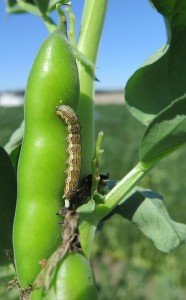As temperatures start to warm up there are a number of insect pests becoming active and causing crop damage. This post provides an overview of current and potential issues for field crops.
Helicoverpa populations in pulses have not really gone away over winter, but their activity is now increasing, with H. armigera moths already being caught in phermone traps. This indicates that a proportion of the population did not go into diapause this winter. The risk of crop loss is now increasing as crops set and mature grain. In chickpea, Altacor (chlorantraniliprole) is now registered and a good option along with Steward (indoxacarb) and VivusMax (NPV) in regions where insectide-resistant H. armigera are present. In linseed, helicoverpa are often present from budding. Err on the the side of early if you have linseed crops as significant damage to flowers, buds and bolls can occur quickly.
In faba beans, helicoverpa have been active for some time and the tolerance for damage is extremely low. As the crops stop flowering and the complex terminal with buds and new leaves disappears, beatsheet sampling appears to be more effective in dislodging the smaller larvae. This means that through podding beatsheet sampling will be giving a more reliable estimate of both numbers and larval size – making decisions about control, and the timing of control easier. Steward, Affirm, VivusMax are softer options for helicoverpa control in faba beans.
Aphid populations in faba beans during May-June have declined through winter, largely because of natural enemy activity. The concerns about the potential impact of virus remain, and Murray Sharman (QDAFF Virologist) will commence a survey of affected crops during September – October to assess the levels of virus infection. Whilst low aphid numbers persisted through winter in many crops, there hasn’t yet been a build up in numbers, which could further impact on yield in virus-infected crops with late spread of virus. However, until we know more about the risk of virus infection, we are not recommending the treatment of aphids to prevent virus impact, particularly in spring when the potential loss is lower than with autumn infection. In the event of aphid outbreak in faba beans or chickpea in spring, pirimicarb can now be used under permit (PER1498, expires 31 Oct14).
Another regular occurrence in spring, particularly in the Border Rivers region, is the appearance of white ‘dead heads’ in wheat and barley, caused by the stem-boring moth Ephysteris silignitis. Chris Teague (Landmark, Goondiwindi) has encountered these larvae causing the occasional dead head in barley. Read more in a previous Beatsheet post.
Armyworm are active in a number of crops, particularly in Northern NSW. At this stage even large larvae are just defoliating the still green crops. The risk of headlopping increases as crops start to dry down. The beatsheet is an effective method for determining armyworm densities, but needs to be combined with a ground search along the rows to detect the large, potentially damaging larvae that tend to shelter during the day and feed at night. Read more on armyworm sampling here.
This winter-spring, QDAFF Field Crops Entomology have a number of trials underway, and results will be reported in the Beatsheet.
- Canola compensation potential in response to simulated aphid damage during flowering (Spring Ridge)
- Efficacy of insecticide options for helicoverpa control in faba beans (Warra)
- Efficacy of Bt for armyworm control in winter cereals (North Star)
- Efficacy and use strategy for NPV in linseed (Bungunya)
- Impact of mirid feeding on faba bean seed quality (Cecil Plains)
These trials are funded by GRDC and made possible through the generous cooperation of growers and agronomists.


